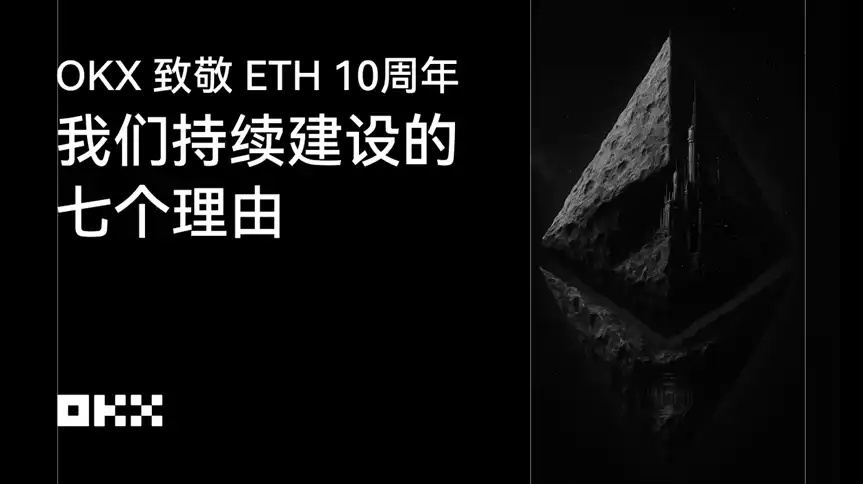
On July 30, 2025, the world celebrates the important moment of the 10th anniversary of Ethereum's establishment. Ethereum, a community-driven and open-source governance blockchain platform, continues to lead technological evolution and application expansion. It has developed from the pioneer of smart contracts into the core foundation of the entire Web3 ecosystem, triggering systemic changes in financial innovation, asset programmability, and data sovereignty. Moreover, it continues to break through in areas such as scalability, privacy computing, and cross-chain interoperability, becoming a dominant infrastructure.
Currently, Ethereum supports over 50% of the world's non-Bitcoin digital assets, including approximately 60% of the total stablecoin issuance, over 60% of the locked capital in decentralized finance (DeFi), and as much as 80% of real-world assets (RWA) mapped on-chain, such as stocks, money market funds, and bonds. This achievement solidifies Ethereum's central position in the global digital economy and the Web3 ecosystem.
Over the past decade, we have steadfastly built the Ethereum ecosystem. Behind this, there are seven reasons we have always adhered to.
1. Leading Developer Ecosystem
1.1 Rich Developer Ecosystem and Growth Trends
In 2015, the Ethereum mainnet launched with approximately 1,085 active developers. By 2024, there are about 23,613 active blockchain developers globally, with a ten-year compound annual growth rate of 39%; Ethereum has consistently maintained the largest developer community.
In 2024, around 16,700 new developers contributed code to the Ethereum ecosystem, three times that of Polygon and nearly four times that of Solana. Despite the impact of the bear market in recent years, the total number of active developers in Web3 has slightly decreased from its peak (down about 7% year-on-year), but the number of "senior developers" with over two years of experience has increased by 27%, providing stable support for ecosystem innovation.
Senior developers (with over two years of code contributions) account for over 70% of the total, becoming the cornerstone of continuous innovation in the Ethereum ecosystem.
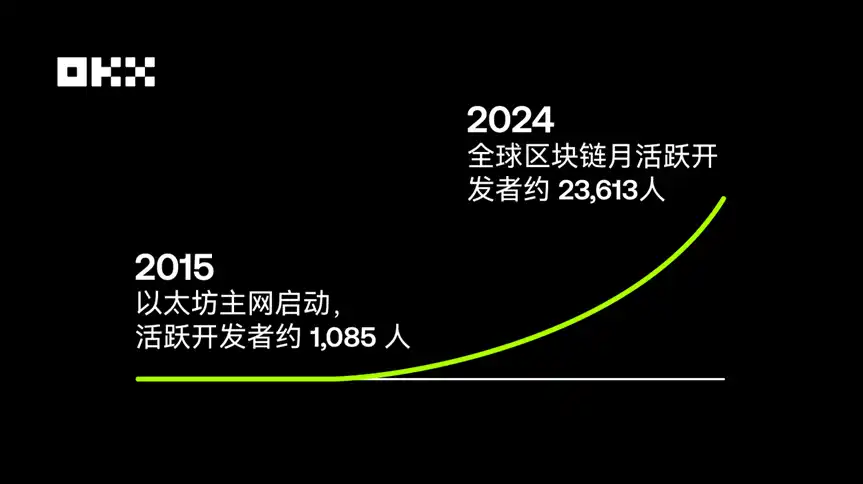
1.2 Continuous Expansion of the EVM Ecosystem and Network Effects
Currently, one-third of global crypto developers are multi-chain developers, with 34% actively working on more than two public chains each month, a significant increase from 10% in 2015.
The Ethereum Virtual Machine (EVM) ecosystem shows a clear aggregation effect: 74% of multi-chain developers have active contributions on EVM chains, and EVM cross-chain deployers have increased fourfold since 2021.
EVM-compatible chains like Base, Polygon, and Starknet attract a large number of developers, sharing toolchains and codebases, significantly lowering the barriers to innovation and enhancing ecosystem stickiness.
The "code innovation" of the EVM ecosystem is migrating towards Layer 2 and new chains: in 2024, the mainnet and L2s together carried 65% of innovative code, with Base once accounting for 25% of EVM innovation logic.
In 2023, there were 17 crypto ecosystems globally, each attracting over a thousand active developers monthly, with EVM chains occupying the majority of positions.
1.3 Ethereum (Solidity/EVM) Remains the Public Chain with the Most Developers and Richest Ecosystem
Solana (Rust) developers are growing rapidly, with the number of new developers in 2024 surpassing Ethereum for the first time, but the total developer scale is still not comparable to Ethereum.
The Move ecosystem, represented by Aptos and Sui, still has a developer base far below that of EVM and Rust chains, but shows significant growth, focusing on asset security and resource orientation, with a concentration of specialists.
Ethereum has set open standards and benchmarks for development tools in the blockchain industry, from code frameworks (such as Hardhat, Foundry, OpenZeppelin) to infrastructure (such as L2 Rollup, NFT protocols), effectively lowering the entry barriers and learning costs for global developers.
2. Continuously Growing and Innovative Scaling Ecosystem
2.1 Ecosystem Evolution and Innovation Leadership
The launch of the Ethereum mainnet in 2015 marked the beginning of a new era for smart contracts and decentralized applications (dApps). Over the past decade, Ethereum has driven multiple rounds of innovation in DeFi, NFTs, and RWAs (real-world assets), becoming the foundational infrastructure and innovation hub for global blockchain applications.
Ethereum's Rollup scaling (such as Optimism, Arbitrum, zkSync), sharding, and state pricing mechanism innovations (upgrades like Pectra) have significantly improved network throughput and user experience.
Application scenarios have expanded from DeFi and NFTs to RWAs, AI on-chain, social, and GameFi, greatly enriching the on-chain ecosystem and cross-border innovation.
2.2 Overview of Ecosystem Innovation Data and On-Chain Metrics
Total Locked Value (TVL) Changes:
In 2025, the DeFi TVL reached approximately $62.95 billion, a year-on-year increase of 30%, accounting for over 53% of the global DeFi ecosystem. Leading protocols include Lido, Aave, EigenLayer, Etherfi, and Sky. The market expects Ethereum's TVL to exceed $100 billion by the end of 2025.
The TVL of Layer 2 solutions like Rollup continues to rise, with the EVM ecosystem dominating multi-chain interactions.
Transaction Volume and Activity:
Ethereum's average daily transaction volume (July 2025): 1,605,000 transactions, a 44.6% increase compared to the same period last year, with network activity reaching a new high.
The number of active wallets in 2025 has reached 127 million, a year-on-year increase of 22%, with multi-chain interoperability strengthening the user base and developer foundation.
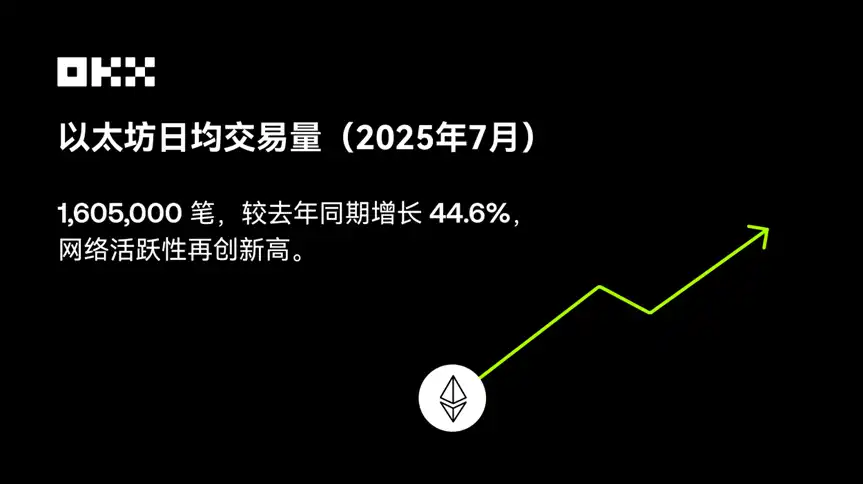
2.3 ETH Leading the Development of the RWA Ecosystem
As of July 2025, the total scale of on-chain RWAs reached $24.8 billion, with over 54.9% issued on the Ethereum main chain.
Assets and Holders: A total of 341 RWA assets have been issued on Ethereum, with 81,388 asset holders.
Stablecoin Support: As a key infrastructure for RWAs, the market value of stablecoins on Ethereum is approximately $141.01 billion, accounting for 54.7% of the total market value of stablecoins. The number of stablecoin holders in the Ethereum network exceeds 14.74 million.
In Ethereum Layer 2, the scale of ZKsync Era RWAs reached $2.334 billion, with 38 asset types, accounting for 18.33% of the RWA market share.
Asset types include U.S. Treasury bonds, gold, money market funds, stocks, corporate bonds, etc., with leading projects such as BlackRock BUIDL, Paxos Gold PAXG, and Tether Gold XAUT. Among them, BUIDL has a single asset scale exceeding $2.43 billion, and PAXG exceeds $940 million.
There are 320,000 global RWA asset holders and 255 institutions and service providers, with a rapid year-on-year growth in the issuance speed of new RWAs.
3. Continuously Improving Performance and Scalability
3.1 Review of Technical Upgrade Progress
Since its inception in 2015, Ethereum has undergone multiple rounds of significant technological evolution in performance and scalability, bringing profound impacts to the blockchain industry, including:
2017 Byzantium Upgrade: Introduced multiple EVM optimizations, reduced mining rewards, and laid the foundation for subsequent iterations of on-chain smart contracts.
2019 Istanbul and Constantinople: Improved transaction fee efficiency, enhanced support for Layer 2, and increased network resistance to attacks.
2020–2021 Beacon Chain & The Merge Preparation: The Beacon Chain initiated the transition to Proof of Stake (PoS), laying the groundwork for an efficient and secure consensus mechanism.
2022 The Merge (Bellatrix/Paris/Shapella): The mainnet and Beacon Chain merged, fully completing the PoS transition, reducing energy consumption by over 99%, and clearing obstacles for future scalability upgrades.
2024–2025 Dencun/Pectra Upgrade: Technological advancements represented by EIP-4844 (Proto-Danksharding) introduced data structures related to sharding for the first time, optimizing data transmission bandwidth and significantly reducing L2 transaction costs.
As of 2025, Ethereum has achieved significant reductions in energy consumption, further enhanced security, and strategically transferred idle load from the mainnet to Layer 2 through the aforementioned upgrades, providing a solid foundation for subsequent large-scale scalability.
3.2 Layer 2 Technology Progress and Data Evolution
The success of Ethereum's ecosystem scaling is inseparable from the explosive development of Layer 2 networks:
As of July 2025, the Ethereum Layer 2 networks (including Arbitrum, Optimism, Base, zkSync Era, etc.) reached a peak TPS, with an average daily combined TPS exceeding 50, processing millions of transactions in a single day, surpassing the mainnet.
Mainstream L2 transaction fees are typically below $0.10 per transaction, far lower than the mainnet average of $0.75 per transaction.
Leading Layer 2 Ecosystem and Protocol Progress:
Arbitrum, Optimism, Base, zkSync Era, StarkNet, and Polygon zkEVM have become major hubs for funds and users.
In 2025, the TVL of Layer 2 continues to grow, with Arbitrum and Optimism combined locking over $10 billion, while Base has emerged as a strong contender, at one point leading in TPS and accounting for 40% of the entire ecosystem's transaction processing capacity.
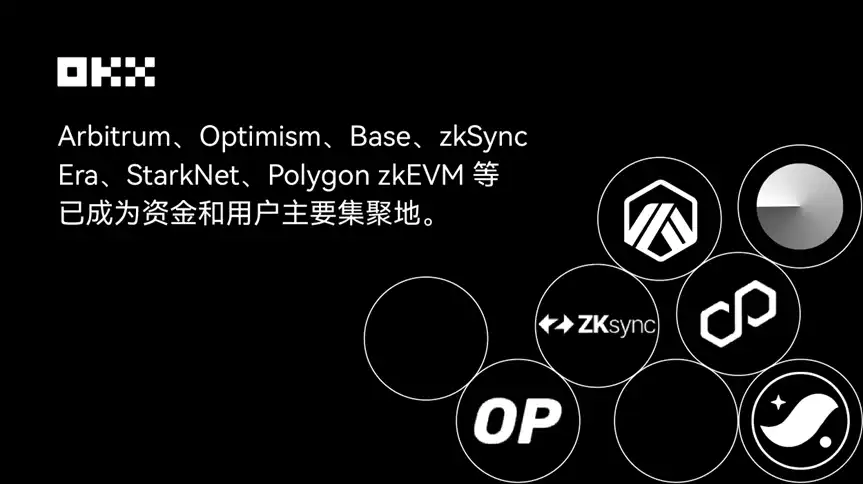
3.3 Technical Outlook
Based on L1 Rollup Dual-Track Pattern: The future Ethereum ecosystem will evolve into two parallel Rollup models. One type is the Based Rollup, which is deeply aligned with Ethereum, utilizing L1 for native ordering and verification, inheriting its top-tier security and trust neutrality, primarily serving high-value scenarios such as DeFi, governance, and asset custody. The other type is high-performance Rollup, which optimizes throughput and experience for large-scale user scenarios like gaming and social applications, typically employing centralized ordering or alternative data availability (DA) solutions. This differentiation will lead to market consolidation, with intermediate Rollups lacking clear performance or security alignment advantages being marginalized.
Technical Leap of Layer 1: Ethereum L1 is transitioning from "heavy execution" to "light verification" zkEVM paradigm, enhancing its performance and decentralization level through comprehensive architectural upgrades:
The execution layer introduces RISC-V virtual machines to improve zero-knowledge proof efficiency and broaden the developer ecosystem.
The settlement layer achieves native verification of Rollups through EXECUTE precompiled functions, turning it into protocol-level execution sharding.
The consensus layer upgrades to Beam Chain, shortening finality to about 12 seconds and lowering the validator threshold to 1 ETH, significantly enhancing network neutrality.
The data availability layer leverages Danksharding, increasing throughput capacity to support the ecosystem in achieving tens of millions of TPS.
The restructured L1 will become the undisputed global asset settlement layer. Its enhanced security and neutrality provide a solid foundation for Based Rollups, attracting high-value applications and liquidity. The value generated by these Rollups, such as MEV and transaction fees, will flow back to the Ethereum mainnet, strengthening ETH's economic model and security budget. This predictable, highly secure underlying protocol is key to gaining institutional trust and promoting the adoption of real-world assets (RWA) and large-scale financial applications.
"Trustware": The Trust Engine of the Global Economy. Ethereum is evolving into a "Trustware," a set of infrastructures that industrializes trust production. It generates the validity and finality essential for the digital world at an extremely low marginal cost through algorithms, replacing the expensive and inefficient legal, auditing, and intermediary institutions of traditional finance. In this way, Ethereum provides a scalable trust foundation for the digitization of global assets, capital, and financial transactions, aiming to become the global ledger supporting the future digital economy.
Decentralization and Security
4.1 Extensive Node Distribution
Global Consensus and Network Effects:
Over the past 10 years, ETH has formed a sufficient global consensus through a network of nodes spread across the world. ETH has deployed 8,665 nodes in 86 countries.
The number of ETH nodes continues to grow, with the rise in ETH prices and market expectations directly incentivizing more users to participate in node operations. In the past 7 days, the number of nodes increased by 8.06%, reflecting holders' strong confidence in ETH's future development.
Bilateral Recognition Between the U.S. and China Brings High Mainstream Consensus:
In the ETH node network, the U.S. and China dominate, with 3,986 nodes (45.73%) and 2,154 nodes (24.71%) respectively, accounting for over 70.44% of the total, indicating that ETH has gained high recognition in both major Eastern and Western economies.
The developed infrastructure, mature developer ecosystem, and high cryptocurrency adoption rates in the U.S. and China provide strong support for the stable operation of the ETH node network. The widespread deployment of ETH in these two countries not only enhances network security but also lays a solid foundation for its further application in global finance and technology.
Extensive Decentralization and Security:
ETH nodes are distributed across 6 continents: European nodes are second only to North America, including countries like Germany, the UK, and the Netherlands; although Asia has strict cryptocurrency regulations, China, Japan, and South Korea still operate a large number of nodes; South America, Oceania, and Africa are growing rapidly, with countries like Brazil, Argentina, Australia, New Zealand, South Africa, and Nigeria showing strong potential for ETH in emerging markets.
Although the U.S. and China have an absolute advantage, there are still over 10 countries with a node percentage exceeding 1%, including Germany, Japan, France, the UK, Canada, Singapore, and the Netherlands. If the execution layer and consensus layer are counted separately, their node distribution would be even more dispersed, which is an unbreakable cornerstone of ETH being recognized as the most decentralized and secure public chain.
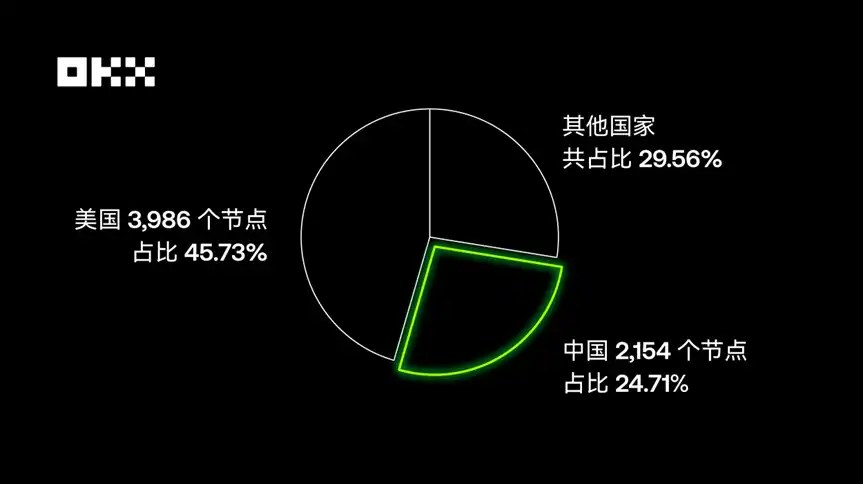
4.2 Diverse Clients
Large-Scale Diverse Clients:
The execution layer of ETH currently has 6 mainstream clients (excluding those with negligible market share), including Geth, Nethermind, Besu, Erigon, Reth, and EthereumJS, with a total of 15,018 clients running. These clients each have unique features that meet the needs of different users and developers. Geth, as the most widely used client, is directly maintained by the ETH Foundation; Nethermind and Besu focus more on enterprise-level applications, providing high performance and scalability; Erigon and Reth focus on optimizing data storage and synchronization efficiency, offering developers more efficient tools.
In the consensus layer, ETH also supports 6 mainstream clients (excluding those with negligible market share), including Lighthouse, Lodestar, Nimbus, Teku, Prysm, and Grandie, with a total of 8,850 clients running. They ensure the diversity and security of the ETH consensus mechanism through different technological implementations. For example, Lighthouse is known for its high performance and low resource consumption, making it suitable for individual node operators; Prysm has become the choice of many institutions due to its ease of use and rich features.
Comprehensive Support for Multiple Languages and Systems:
ETH clients perform excellently in terms of technical compatibility, fully supporting mainstream development languages, including Go, Java, and Rust. This not only lowers the learning costs for developers but also attracts developers from different technical backgrounds to participate in ETH ecosystem construction. Geth is suitable for developers familiar with Go; Nethermind is based on the .NET framework, providing convenience for C# developers; Reth and Lighthouse use Rust, attracting developers focused on performance and security.
ETH clients are fully compatible with mainstream operating systems such as Linux, Windows, and MacOS, meeting the needs of different technical stacks. This cross-platform compatibility not only enhances the usability of clients but also expands ETH's user base. For example, individual developers can quickly set up nodes in a Windows environment, while enterprise users can deploy high-performance clients on Linux servers.
The strong compatibility has earned ETH widespread community support. Geth, as the official client of the ETH Foundation, has a large developer community and rich documentation resources; Nethermind and Besu have promoted ETH's implementation in enterprise-level applications through deep cooperation with enterprises. The diversity of clients not only ensures technological innovation and iteration but also accelerates the development of the ETH technology ecosystem.
4.3 Restaking Data
Restaking Scale Steady Growth, Rich Protocols:
As the origin of the Restaking and Liquid Restaking narrative, ETH's ecosystem scale continues to expand with the sustained rise in ETH prices. The ETH Restaking TVL exceeds $19.96 billion, accounting for 76% of the total ecosystem of $26.41 billion, which is 4.9 times that of the second-ranked BTC ecosystem at $5.42 billion. The continuously rising TVL not only improves capital utilization but also enhances the security of the ETH network.
The ETH LST TVL exceeds $14.08 billion, accounting for 95% of the total ecosystem of $14.75 billion, which is 48.5 times that of the second-ranked Solana ecosystem at $290 million. By converting staked assets into liquid tokens, it provides users with greater capital flexibility, attracting a large number of DeFi protocols to participate, and ETH maintains an absolute advantage in this field.
The ETH Restaking ecosystem is not only large in scale but also nurtures multiple innovative protocols. EigenLayer and Symbiotic are the most representative, with TVLs of $18.1 billion and $1.54 billion, respectively; the LST protocols are even richer, with 7 protocols having TVLs exceeding $100 million and 3 protocols exceeding $1 billion, namely ether.fi at $9.8 billion, Kelp at $1.56 billion, and Renzo at $1.14 billion. The number and diversity of protocols far exceed those of other ecosystems.
Self-Iterating Official Governance Organization
5.1 Continuous Elevation of EF Management
EF Welcomes a New Management Team:
In March, EF announced the most significant leadership change in recent years: former Executive Director Aya Miyaguchi transitioned to the role of Foundation Chair, with Hsiao-Wei Wang and Tomasz Stańczak appointed as Co-Executive Directors, and researcher Danny Ryan joining the new organization Etherealize.
Since 2018, Aya Miyaguchi has served as the Executive Director of EF, leading ETH through numerous milestones. After transitioning to the chair position, she will focus more on promoting strategic cooperation and maintaining relationships, reducing direct involvement in specific affairs. The management team adjustment after 7 years sends a clear signal of EF's self-iteration to the outside world.
The dual Executive Director structure of Hsiao-Wei Wang and Tomasz disperses decision-making responsibilities and reduces single points of failure risk. Their respective technical and management backgrounds form a strong complement, and this management update has received congratulations and welcomes from the community and industry institutions.
The New Management Team Brings Clear Direction and Focus:
Hsiao-Wei Wang emphasized that in the long term, they will drive the Foundation's work with "guiding principles" (core values) and "specific goals" (measurable impact and resilience). The four cornerstones of ETH—censorship resistance, open-source innovation, privacy protection, and security—remain the underlying basis for all their decisions and actions.
For the next year, they will clearly focus on three key points: expanding the scalability of the ETH mainnet (L1), optimizing data Blob processing, and improving overall user experience (UX). They also mentioned specific initiatives such as institutional-level SDKs (integrated custody interfaces, compliance review, and gas fee optimization modules), enterprise wallets based on the Noir zero-knowledge compiler, entering the Asia-Pacific and European markets, and collaborating with the Singapore Digital Port and the Swiss Crypto Valley.
Three New Organizations:
This year, EF has established three important organizations, each focusing on technology, governance, and institutional integration.
The most notable, Etherealize, is the institutional-level marketing and product department of the ETH ecosystem, aimed at promoting ETH's adoption in traditional financial markets (such as Wall Street). While pushing institutions to adopt ETH as a value storage asset and underlying technology platform, it also builds financial products to connect the ETH ecosystem with institutional funds, enhancing the economic cycle of the mainnet. The establishment of Etherealize clarifies EF's determination to promote institutional adoption and build open finance.
The EF Silviculture Society is an advisory group composed of 15 non-foundation members, primarily responsible for ensuring that the development of the ETH ecosystem aligns with core values such as open source, privacy, security, and censorship resistance, demonstrating EF's respect for senior developers and industry experts and its confidence in further optimizing community governance structures.
Ethereum Foundation Research is positioned as EF's research center, consisting of five teams: Application Research Group (ARG), Consensus R&D, Cryptography, Protocol Security, and RIG, covering the five most important aspects of ETH's future development path, providing foundational support for technological evolution.
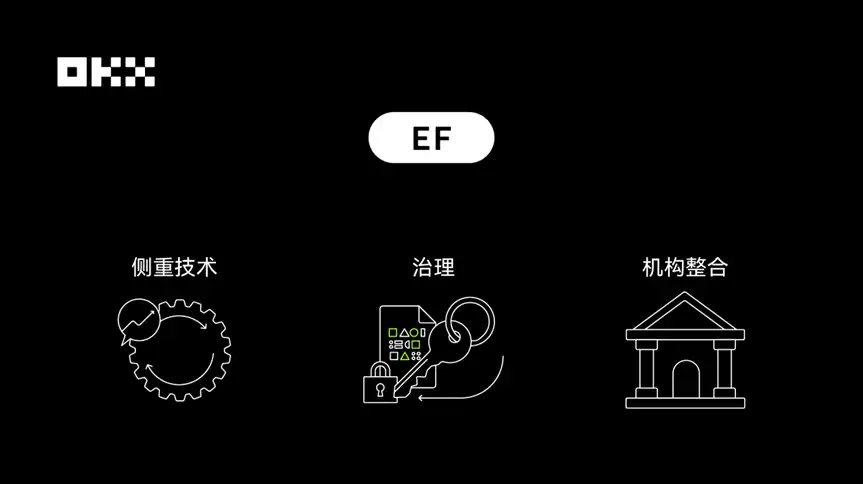
5.2 Advanced Cluster Community Governance Structure
EF has always emphasized that it is a non-profit organization and does not adopt a top-down corporate structure, but rather resembles a community cluster. The foundation supports numerous semi-autonomous teams that operate independently in their respective areas of expertise while organically collaborating under shared values.
EF's organizational structure can be divided into four functional areas: Protocol R&D (PR&D), Ecosystem Development (EcoDev), Operational Support (Ops), and Privacy and Scalability Exploration (PSE). EF plays a bridging role in cross-team collaboration but does not micromanage every project, encouraging teams to "take initiative and fulfill their responsibilities." This governance philosophy and practice have set an excellent benchmark for the entire industry.
5.3 Unchanging "Infinite Garden" Vision
Guarding the "Infinite Garden":
In April, Aya Miyaguchi and Vitalik Buterin jointly published an article titled "The Vision of the Ethereum Foundation," reiterating EF's mission, role, high-priority matters, and core principles. They pointed out that the power of ETH should not only be reflected in a decentralized technical architecture but should also extend to broad decentralization and autonomy at the organizational level.
EF positions itself as the guardian of the "Infinite Garden," not as a centralized power node, but as an entity dedicated to guiding projects, communities, and infrastructure within the ecosystem to enhance the overall energy of the ecosystem. It aims to "complete tasks that only EF can do today" (such as developing diverse clients and coordinating network upgrades) while also "helping others achieve what only EF can do today in the future" (such as funding public goods and local communities).
EF's work focus is also very clear: first, maximize the number of ETH users and ensure that users can truly benefit from ETH's censorship resistance, openness, and privacy protection; second, enhance the resilience of ETH's technical and social infrastructure, ensuring that the ecosystem can operate independently and healthily even in extreme situations.
Future of Ecosystem Development:
On July 10, EF released the latest vision statement for "The Future of Ecosystem Development," first clarifying the goal of maximizing the number of people who directly or indirectly use ETH and benefit from its underlying values. Secondly, it aims to maximize the resilience of ETH's technical and social infrastructure, with specific paths including the introduction of four strategic pillars (Accelerate, Amplify, Support, and Long-term Unblocking), establishing a new governance framework, and reforming its funding management strategy.
In terms of ecosystem acceleration, EF has newly established support modules for specific directions, including: corporate relations, developer growth, application support, and founder support, each with clear leaders and detailed plans.
Regarding funding reform, EF will also reduce the proportion of future operating expenses from 15% to 5% by 2025, gradually approaching the standards of donation-based organizations, and will deploy on-chain assets to ensure long-term financial buffers.
Six, Large-Scale Institutional Adoption
6.1 ETH ETF Becomes a Secondary Rocket for Institutional Funds
ETH ETF Transitions from Neglect to Explosive Growth:
In July 2024, the SEC officially approved the ETH spot ETF. In the initial approval phase, the total trading volume of U.S. ETH ETFs once exceeded $1 billion, demonstrating strong market interest. However, as BTC was still in a price trough at that time, institutional funds were more inclined to increase their positions in BTC ETFs, causing the trading volume of ETH ETFs to quickly drop back to around $200 million, continuing until mid-2025.
With the ongoing friendly regulatory framework and DeFi integrating into traditional financial narratives, ETH's value-carrying capacity has bottomed out again. Since May 2025, the total trading volume of ETH ETFs has gradually risen back above $1 billion, with peak trading volumes exceeding $3 billion.
The net inflow into ETH ETFs has also shown strong growth momentum. In the past two months, ETH ETFs have almost achieved continuous net inflows (except for a few days of low net outflows), with the highest single-day net inflow exceeding $700 million. There is a highly fitted upward trend between ETH prices, single-day net inflows, and total net assets.
As of now, the cumulative net inflow of U.S. market ETH spot ETFs is $8.89 billion, with a total net asset value of $20.48 billion, accounting for 16.2% of the cumulative total net inflow of U.S. market BTC spot ETFs at $54.73 billion and 13.4% of the total net asset value of $153.16 billion, with the gap between the two gradually narrowing.
Institutional Accumulation Improves ETH Holding Structure:
Similar to BTC ETFs, the issuers of ETH ETFs also include major global asset management institutions, such as iShare, Grayscale, Fidelity, Franklin Templeton, VanEck, and Invesco. Currently, there are 9 ETH ETFs, with the number of issuers approaching the 12 of BTC ETFs.
The enthusiastic inflow into various ETFs has improved the holding structure of ETH, with the institutional holding proportion in 2025 being 27%, nearly 2.5 times that of 12% in 2024, while the exchange circulation proportion is 18%, significantly down from 31% in 2024. This not only reflects institutions' long-term optimism about ETH but also provides stronger confidence for ordinary holders.
Meanwhile, as the usage rate of the ETH network warms up, its transaction fees are continuously increasing, effectively offsetting part of ETH's inflation rate. Due to the PoS mechanism and the EIP-1559 burn mechanism, ETH's inflation rate has been significantly suppressed. As of July 2025, Ethereum's inflation rate is at a low level.
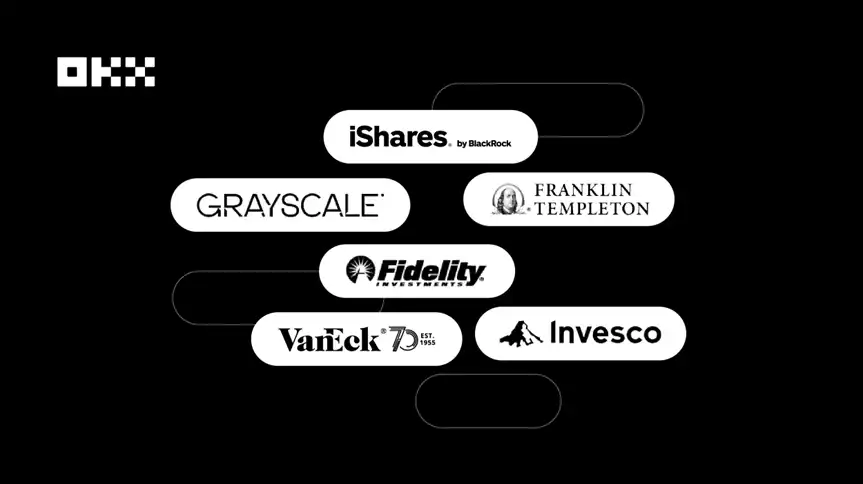
6.2 ETH Becomes an Important Treasury Asset in U.S. Stocks
ETH Treasury Strategy Rapidly Responds in U.S. Stock Market:
With the BTC treasury strategy opening the way in the U.S. stock market, ETH, as a quality asset, has also quickly found its own treasury strategy flywheel. Currently, the ETH treasury strategy reserves 2.31 million ETH, with a net value of $8.56 billion, a figure that is approaching 40% of the ETF holdings and net value.
Currently, there are 63 companies that have officially established ETH ETF treasury strategies, compared to 5 in April 2025, indicating that this strategy has gained high consensus among institutions in just four months.
The most representative companies, SharpLink Gaming and Bitmine Immersion Tech, have reserves of 360,000 and 560,000 ETH, respectively, with market values of $1.34 billion and $2.1 billion, exceeding the ETH Foundation's 237,000 ETH; in addition, several other institutions, including Bit Digital, BTCs, GameSquare, and Coinbase, hold tens of thousands of ETH.
More Institutional Holders Will Continue to Elevate ETH Consensus:
Institutions establishing ETH treasury strategies are also highly diversified, with heavyweight players entering the market one after another. Catherine Wood's ARK Invest is advancing its ETH treasury by acquiring $182 million in BMNR common stock. SharpLink Gaming, in its private financing in May, also gained participation from Consensys, ParaFi Capital, Electric Capital, Pantera Capital, and Galaxy Digital. Joseph Lubin, co-founder of ETH and founder and CEO of Consensys, serves as the chairman of SharpLink's board, while the driving force behind Bitmine's establishment of ETH strategic reserves is Wall Street strategist and Fundstrat co-founder Thomas Lee.
In addition to ETF institutions, U.S. stock companies, and crypto companies, other types of institutions are also adopting ETH as a primary asset type. The Trump family's WLFI, since its establishment in December 2024, has at one point held up to 70,000 ETH and continues to purchase.
Joseph Lubin also stated in June that the company is exploring the possibility of building infrastructure in the ETH ecosystem with a certain sovereign wealth fund and bank. With the entry of diverse institutional holders, the consensus around ETH will become more three-dimensional and widespread.
Crypto projects and exchanges are also actively increasing their holdings of ETH. In addition to the Ethereum Foundation, PulseChain holds 166,000 ETH, Golem Foundation holds 101,000 ETH, Gnosis DAO holds 66,000 ETH, and Coinbase holds 137,000 ETH.
Referring to the growth path of BTC, we believe that the new round of value bottoming for ETH is still ongoing. With the large-scale adoption by institutions, the value attributes of ETH will further differentiate from other altcoins and align more closely with BTC. At the same time, ETH's unique decentralization, security, and on-chain economic ecosystem will continue to couple with traditional finance, further enhancing ETH's value capture ability. Therefore, we believe that ETH will have good upward sustainability.
Seven, Good Cooperation with OKX
7.1 OKX as a Firm Builder of the Ethereum Ecosystem
OKX Wallet in ETH Ecosystem Data:
One of the earliest wallets to support the Ethereum network and its ecosystem, quickly responding to every official upgrade.
In 2024, the daily API call volume for Ethereum provided by OKX Wallet has exceeded 900,000 times, covering core capabilities such as wallet management, smart contract interaction, and on-chain data querying.
In 2024, Justin Drake, a member of the Ethereum Foundation (hereinafter referred to as "EF"), had an in-depth dialogue with Owen, the head of OKX Web3 products, discussing various aspects such as technical improvements of Ethereum 2.0, consensus mechanisms, scalability, security, DeFi, user experience, ecosystem, environmental impact, and future development and strategy.
In July 2025, OKX Wallet co-hosted three major "Builder Experiences" exclusive events, including the ETHCC Cannes 2025 Builder's Club, inviting over 150 core project teams and ecosystem developers to participate, promoting Web3 innovation and collaboration through technical sharing, hackathons, and closed-door discussions.
OKX launched the "ETH Half-Price Carnival" event, during which users have the chance to win a reward of 0.5 ETH for every 1 ETH traded, with a maximum of 10 participations per person. Each day, 10 prizes of 0.5 ETH will be released; new users making their first trade of 100 USDT can receive a coupon for an annualized interest rate of 26.08%; by publishing event content and successfully inviting one new user to trade, they can also receive a 100 USDT contract experience bonus.
OKX Ventures Invests in Numerous Core Ethereum Tracks:
Infrastructure and scaling, such as: Arbitrum, ZKsync, Scroll, Taiko, StarkWare
Decentralized staking and re-staking, such as: SSV, ether.fi, Renzo
AI and on-chain applications, such as: Myshell, Altlayer
Cross-chain and data availability, such as: Avail
In the future, OKX Ventures will continue to delve into the Ethereum ecosystem, capturing opportunities brought by technological iterations and emerging use cases, supporting the long-term development of the industry.
Over the past decade, Ethereum has not only been a public chain but also a force. It has transformed imaginative ideas into real operational code, returning financial and contractual scenarios that previously required layers of intermediaries directly to developers and users. Every deployment of a smart contract and every transaction in decentralized finance proves that decentralized collaboration and transparent governance can support an open and inclusive digital world. Over the years, Ethereum has carried people's desires for autonomy and fairness, witnessing how the community continues to strive for a common ideal.
On this journey, OKX has never stood by. Through Wallet, it builds on-chain entry points, trading aggregators, explorations, and more, allowing users to easily experience its infinite possibilities; through investment and incubation, it gives innovative projects the opportunity to take root and grow. We are not hurried passersby but builders walking alongside: at every critical moment of Ethereum, we are willing to contribute technology, resources, and enthusiasm, growing together and welcoming a more distant future.
Because builders are the most devout believers in Ethereum.
Disclaimer
This article is for reference only. It represents the author's views. This article does not intend to provide (i) investment advice or recommendations; (ii) offers or solicitations to buy, sell, or hold digital assets; (iii) financial, accounting, legal, or tax advice. We do not guarantee the accuracy, completeness, or usefulness of such information. Holding digital assets (including stablecoins and NFTs) involves high risks and may fluctuate significantly. You should carefully consider whether trading or holding digital assets is suitable for you based on your financial situation. Please consult your legal/tax/investment professionals regarding your specific circumstances. You are responsible for understanding and complying with applicable local laws and regulations.
This article is from a submission and does not represent the views of BlockBeats.
免责声明:本文章仅代表作者个人观点,不代表本平台的立场和观点。本文章仅供信息分享,不构成对任何人的任何投资建议。用户与作者之间的任何争议,与本平台无关。如网页中刊载的文章或图片涉及侵权,请提供相关的权利证明和身份证明发送邮件到support@aicoin.com,本平台相关工作人员将会进行核查。




